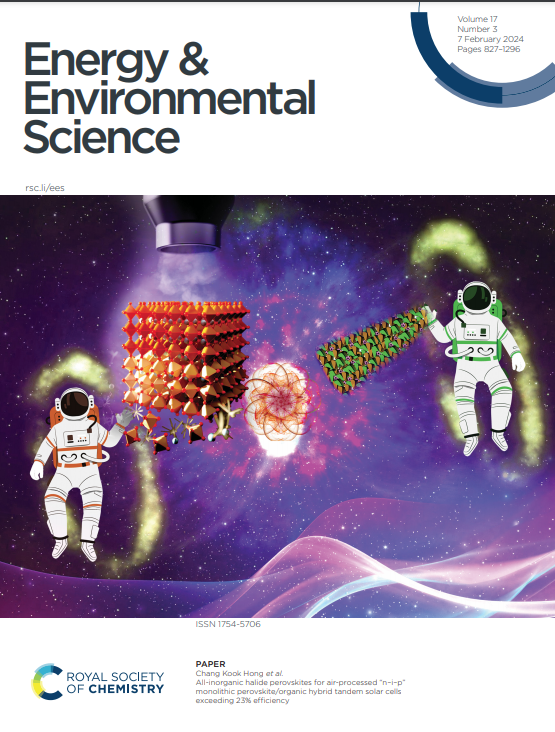From Generation to Collection – Impact of Deposition Temperature on Charge Carrier Dynamics of High-Performance Vacuum-Processed Organic Solar Cells
IF 32.4
1区 材料科学
Q1 CHEMISTRY, MULTIDISCIPLINARY
引用次数: 0
Abstract
Vacuum-processed organic solar cells (VP-OSCs) possess many advantages for scalability. However, as the academic community focusses on high performing solution-processed OSCs, detailed studies about the relation between morphology and device characteristics in VP-OSCs are rare. Here, we present a study on a model donor/fullerene VP-OSC system deposited at different substrate temperatures. Substrate heating results in increases in current density and fill factor (FF). Changes in morphology are characterised by grazing-incidence wide-angle scattering (GIWAXS) and resonant soft X-ray scattering (RSoXS). The increase in the degree of crystallinity and preferential orientation of the donor molecule in heated samples results in enhanced absorption increasing current density. The exciton and charge separation efficiency were studied by transient absorption and photoluminescence quenching showing only minor differences. To study the FF differences, charge transport and non-geminate recombination are studied by optoelectronic measurements and device simulations. The charge carrier kinetics are governed by a large density of trap states. While the energetic disorder and non-geminate recombination under open circuit conditions remain largely unchanged, the increased effective mobility and lower transport disorder observed in photocurrent transients explain the increased collection efficiency for heated devices. We relate this to the increased donor phase purity. Our results suggest that charge recombination and transport are governed by different aspects of disorder related to amorphous and crystalline donor phases. Quantitative comparison with high FF solution-processed OSCs reveals that the low mobility limits FF. Finally, drift-diffusion simulations give an outlook for possible performance increases through further optimisation of the deposition control.从生成到收集--沉积温度对高性能真空处理有机太阳能电池电荷载流子动力学的影响
真空处理有机太阳能电池(VP-OSC)在可扩展性方面具有许多优势。然而,由于学术界将重点放在高性能溶液法有机太阳能电池上,有关 VP-OSC 形态与器件特性之间关系的详细研究并不多见。在此,我们对在不同基底温度下沉积的供体/富勒烯 VP-OSC 系统模型进行了研究。基底加热导致电流密度和填充因子(FF)增加。掠入射广角散射(GIWAXS)和共振软 X 射线散射(RSoXS)表征了形貌的变化。加热样品中供体分子的结晶度和优先取向的增加导致吸收增强,电流密度增大。通过瞬态吸收和光致发光淬灭对激子和电荷分离效率进行了研究,结果显示两者仅有微小差异。为了研究 FF 差异,通过光电测量和器件模拟研究了电荷传输和非胶凝重组。电荷载流子动力学受大量陷阱态密度的支配。虽然开路条件下的能量无序和非基态重组基本保持不变,但在光电流瞬态中观察到的有效迁移率增加和传输无序降低解释了加热器件收集效率提高的原因。这与供体相纯度的提高有关。我们的研究结果表明,电荷重组和传输受非晶体和晶体供体相不同方面的无序性支配。与高 FF 溶液加工 OSC 的定量比较显示,低迁移率限制了 FF。最后,漂移扩散模拟为通过进一步优化沉积控制来提高性能提供了前景。
本文章由计算机程序翻译,如有差异,请以英文原文为准。
求助全文
约1分钟内获得全文
求助全文
来源期刊

Energy & Environmental Science
化学-工程:化工
CiteScore
50.50
自引率
2.20%
发文量
349
审稿时长
2.2 months
期刊介绍:
Energy & Environmental Science, a peer-reviewed scientific journal, publishes original research and review articles covering interdisciplinary topics in the (bio)chemical and (bio)physical sciences, as well as chemical engineering disciplines. Published monthly by the Royal Society of Chemistry (RSC), a not-for-profit publisher, Energy & Environmental Science is recognized as a leading journal. It boasts an impressive impact factor of 8.500 as of 2009, ranking 8th among 140 journals in the category "Chemistry, Multidisciplinary," second among 71 journals in "Energy & Fuels," second among 128 journals in "Engineering, Chemical," and first among 181 scientific journals in "Environmental Sciences."
Energy & Environmental Science publishes various types of articles, including Research Papers (original scientific work), Review Articles, Perspectives, and Minireviews (feature review-type articles of broad interest), Communications (original scientific work of an urgent nature), Opinions (personal, often speculative viewpoints or hypotheses on current topics), and Analysis Articles (in-depth examination of energy-related issues).
 求助内容:
求助内容: 应助结果提醒方式:
应助结果提醒方式:


